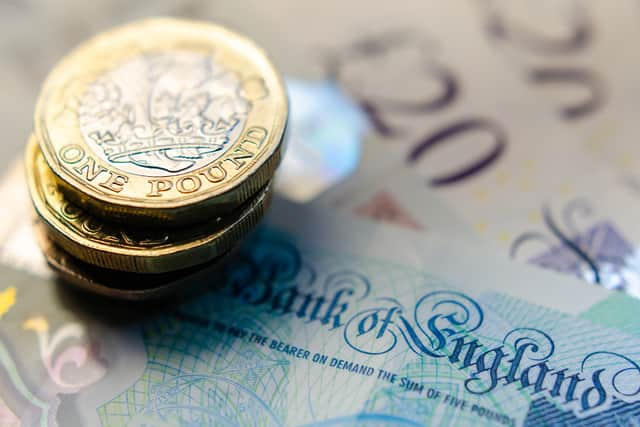How do savings accounts UK work? Best rates, how to grow your money - saver bank accounts explained
and live on Freeview channel 276
With a new tax year about to come in and the cost of living crisis still raging, you may be thinking about how you can bolster your personal finances.
Near-record inflation is eroding the value of our money, with major bill hikes in April only adding to this financial pressure. Meanwhile, high interest rates are making mortgages more expensive at the same time as they are bolstering how much money you can earn on your savings.
While savings interest cannot make up for the impact of inflation, it does at least counter it to some extent. And having savings also allows you to build financial resilience for when unexpected costs hit.
If you’re in a position where you’re able to put some cash away, there are several options at your disposal. ISAs can be a great way to build up a long-term savings pot, while regular savings accounts can offer short-to-medium term rewards that make your money work hard.
So, how do different sorts of savings account work - and how can you make the most of them?
What are savings accounts?
A savings account is a type of bank account that pays you back (i.e. gives you interest) for putting money into it. They tend to have more rules attached to them than current accounts, for example you may have to lock your money away for a certain period of time to secure the full interest payment. Broadly, there are five key types you should be aware of:
- Easy-access accounts: you can withdraw your money at any time (although there may be some rules you have to abide by).
- Regular savings accounts: require you to deposit a certain amount in them each month.
- Notice accounts: you have to notify the bank in advance that you’ll be withdrawing cash.
- Short-term fixed rates: your money is locked away at a particular rate for several months. You won’t be able to access it during this fixed period.
- Long-term fixed rates: your money is locked away for a period of years and usually cannot be accessed within this period without incurring a penalty.
If you’re a higher tax rate payer, or you have a big pot of savings you want to put away, you should look into getting an ISA. Savings accounts are only tax-free if your annual interest payments do not exceed £1,000 (for basic-rate taxpayers) or £500 (for higher rate taxpayers).


How can you make the most of savings accounts?
Although savings account interest rates are the highest they’ve been for more than a decade thanks to the 11 consecutive Bank of England rate rises, they are still tracking well below the rate of inflation.
The best rates on more easily accessible accounts tend to be around the 3.5% mark, while longer-term fixes are sitting at around 4.5% (although it depends on the length of fix you opt for). According to moneyfactscompare.co.uk, you’re most likely to find joy with challenger banks.
As of February 2023, the rate of price increases across the UK economy - including everything from hikes to food prices, fuel costs and energy bills - stood at 10.4% on the Consumer Prices Index (CPI). This figure marked a small rise on January’s figure of 10.1% and came despite predictions inflation would reduce.
Given inflation erodes the value of money and is running well above interest rates, you can’t technically save at the moment. But savings accounts do at least enable your cash to grow more than it would if you left it in a standard current account, while also giving you a pot you can access on a rainy day.
In a bid to push inflation down, the Bank of England increased its bank rate to 4.25% from 4%. However, some of the savings rates on offer are failing to reflect recent rises.
Loading....
Conservative MP Harriett Baldwin, who chairs the Treasury select committee, criticised banks for failing to pass these rates on to savers. She told the BBC on 23 March customers were being treated like “cash cows” by banks. She said: “We’ve noticed that since the Bank of England started raising rates, and they are now up to 4.25%, that people who have mortgages on a variable rate, their rate goes up that day. But we’ve also noticed that for savers, the banks have been very slow to raise rates and there are still rates out there for less than 1%.”
Ms Baldwin urged people to shop around for better rates to pressure banks into making faster rate rises. She said her committee had already written to the Financial Conduct Authority (FCA) to ask if it could look into the issue. It comes after the Treasury committee scrutinised bank bosses on the issue earlier this year. She said: “They gave us a range of excuses [about why rates are not being passed on to customers immediately] — I’m afraid they did not hold a lot of water with our committee.”
While there are difficulties in accessing good savings rates on the market, there are several other things you can do to make your money work better in savings accounts.


First, you should check whether you can afford to put any money aside. To do so, you will need to write up a budget for all of your incomings and outgoings in a typical month. If you have only a small amount of money going spare each month, it might be worth putting it into an easy-access savings account that allows you to quickly get hold of it whenever it’s needed.
But you should be aware that these sorts of accounts tend to come with the lowest interest rates on the market. Martin Lewis’s MoneySavingExpert website recommends looking out for ‘bonus’ rate introductory offers to maximise this type of account.
Say you regularly have a bit more disposable income left over each month, it might be worth looking at a regular savings account. This type of account requires that you pay in a set amount each month, and should give you higher interest rates than standard accounts in return.


At the moment, there are several regular savings accounts on offer which are tied to current accounts that currently offer hefty golden handshakes if you switch to them. Natwest and First Direct are among the banking brands offering three-figure sign-on bonuses which have decent savings rates attached to them.
If you are considering a fixed-rate account that will lock away your money for a period, but offers you a decent interest rate, be aware that rates can rise as well as fall. Should they keep going up, your fixed rate might not be paying you as much as another account would - but, as ever with finances, there is always an element of risk you will lose out.
There is a way to get around this conundrum. You can hedge your bets and spread your money across several accounts, or put it into an easy access account. The Bank of England’s latest rates hike could be its last, but it may take time for it to feed into savings rates. So, there is potentially some time yet before interest rates on these accounts reach a peak.
Comment Guidelines
National World encourages reader discussion on our stories. User feedback, insights and back-and-forth exchanges add a rich layer of context to reporting. Please review our Community Guidelines before commenting.
